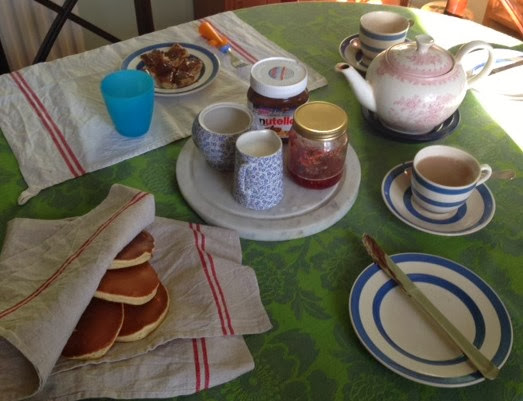Now these pancakes are the traditional Scottish 'drop scones', not french pancakes or 'crepes', but they are similar to the American pancakes which are often eaten with blueberries, maple syrup or even bacon. The recipe is like most pancake recipes, basic with few ingredients. The difficulty in these pancakes is in the cooking - in some ways it should be straight forward and just a case of 'dropping' the batter in the pan and then flipping them over to cook on the other side. However, getting the lovely glossy chestnut coloured smooth top can take a few goes. It's not as straight forward as it should be!
Scottish 'Drop Scones' or pancakes are chestnut coloured with a smooth top and a fluffy interior.
The Recipe
9oz Self Raising flour
3oz Caster Sugar
2 tablespoons golden syrup (not thick black treacle!)
3 eggs
Milk to mix
Put the flour and sugar in a mixing bowl and add the eggs to a hollow in the middle, then plop in the syrup and add a dash of milk to make a soft cake batter mix. Add more milk to the consistency you need.
The trick at this stage is getting the right consistency - you need it runny enough to come off the spoon easily but not too runny that you end up with a thin pancake that only rises a little. We're aiming for a thick fluffy interior so it's a balance of not too thick and not too thin. In the picture above you can see that the batter is running of the spoon but forming a soft pile in the bowl, not sinking and disappearing into liquid once more.
Once you've perfected this stage (!) you can get to the cooking part.
You need a thick bottomed pan like a frying pan. (You can get traditional griddles or girdles here in Scotland for the purpose but they are rare now, usually only found in traditional hardware shops, which I love mooching about in. These are the kind of places you can buy all sorts of cooking paraphernalia.) You'll see above that I've dropped two spoonfuls into the pan together. they are about 3 inches in diameter. Now the key point at this stage is that the pan needs to be medium hot and LIGHTLY oiled with butter. If it too oily you will get a patchwork blotchy top to your pancake and you are looking for a glossy chestnut smoothness instead. I drop a tiny spot of butter in the pan, let it melt, then wipe the bottom of the pan over with a kitchen towl to spread the butter and soak up the excess.
Each pancake will take a couple of minutes to cook on either side but the important bit here is to wait to see the bubbles appearing on the top. When there are quite a lot of bubbles then the pancake is ready to turn over using a fish slice. This is when you learn whether the pan is too cool or too hot or just right! You should have a nice smooth pancake with a rich colouring, anything from golden brown to a rich chestnut. But you don't want it to be too dark or it will taste bitter (although this is how my father likes then *sigh*)
Once they are cooked on both sides then pass them to a warm plate covered in a cotton or linen cloth to keep them warm. We eat ours with Nutella or jam, or just with butter. Actually, pancakes are traditionally eaten for afternoon tea in Scotland, we are a little unusual eating them for breakfast but they are really delicious with your morning cup of tea!
Enjoy your Scottish pancakes!






No comments:
Post a Comment